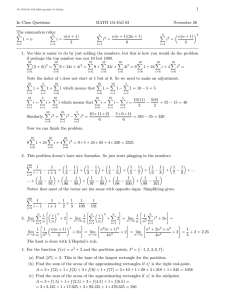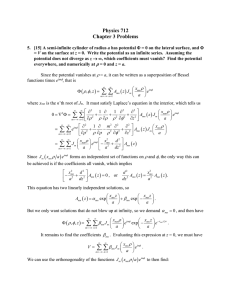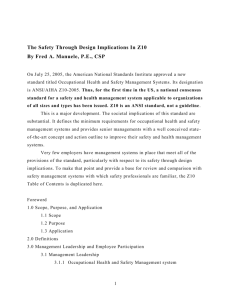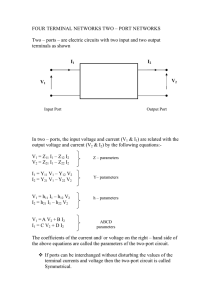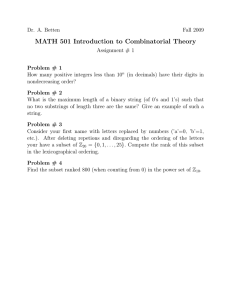Numerical Methods Lecture 6 - Optimization
advertisement
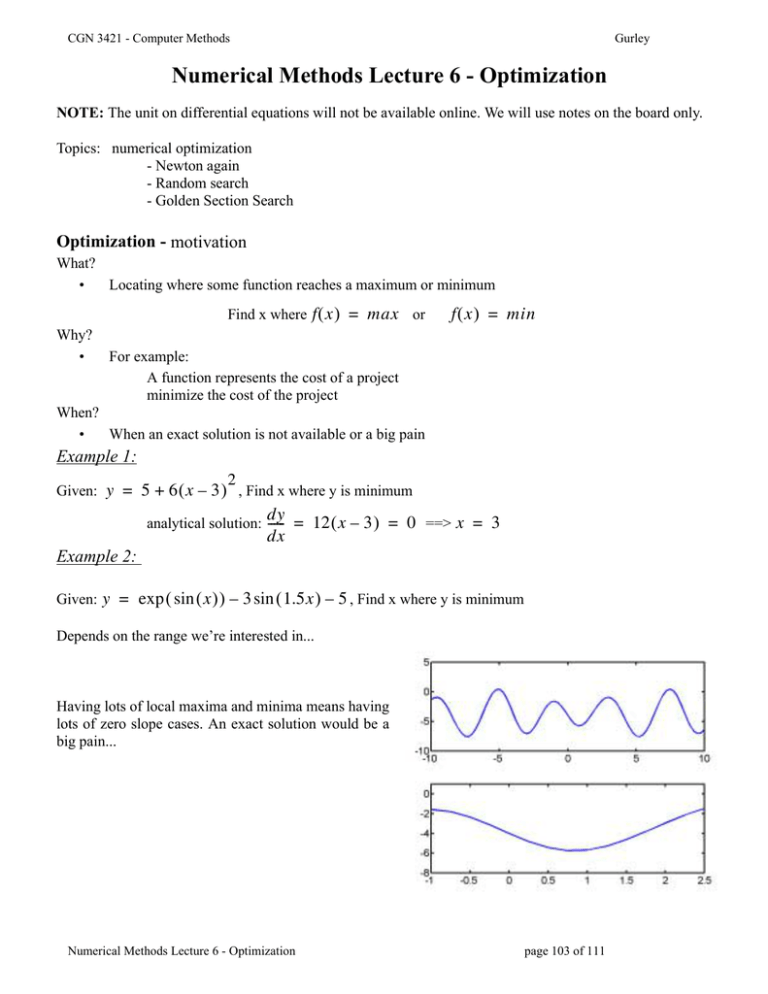
CGN 3421 - Computer Methods
Gurley
Numerical Methods Lecture 6 - Optimization
NOTE: The unit on differential equations will not be available online. We will use notes on the board only.
Topics: numerical optimization
- Newton again
- Random search
- Golden Section Search
Optimization - motivation
What?
•
Locating where some function reaches a maximum or minimum
Find x where ! ( " ) ! #$" or
Why?
•
! ( " ) ! #%&
For example:
A function represents the cost of a project
minimize the cost of the project
When?
•
When an exact solution is not available or a big pain
Example 1:
&
Given: ' ! " ' # ( " % $ ) , Find x where y is minimum
('
("
analytical solution: ------ ! (& ( " % $ ) ! ) ==> " ! $
Example 2:
Given: ' ! ./0 ( *+, ( " ) ) % $ *+, ( (-"" ) % " , Find x where y is minimum
Depends on the range we’re interested in...
Having lots of local maxima and minima means having
lots of zero slope cases. An exact solution would be a
big pain...
Numerical Methods Lecture 6 - Optimization
page 103 of 111
CGN 3421 - Computer Methods
Gurley
Single variable - Newton
Recall the Newton method for finding a root of an equation
! ( ") )
112
(")
" ) ' ( ! " ) % ----------------- , where ! ( " ) ) ! (!
-----------112
("
! ( ") )
We can use a similar approach to find a min or max of ! ( " )
The min / max occurs where the slope is zero
So if we find the root of the derivative, we find the max / min location
112
! (") ! *(") ! )
Find roots of * ( " ) using Newton
112
* ( ") )
!
(")
" ) ' ( ! " ) % -------------- = " ) % --------------1122
*' ( " ) )
! (")
Example: Newton Method
find the maximum of this function
3
$
to find where the
max occurs...
&
! ( " ) ! " % "" % &" ' &3"
we’ll need these
112
$
&
! ( " ) ! 3" % ("" % 3" ' &3
!
1122
&
( " ) ! (&" % $)" % 3
find the root of the
function’s derivative
for x = [0,3]
OR
we can use central difference to replace the analytical derivatives.
Numerical Methods Lecture 6 - Optimization
page 104 of 111
CGN 3421 - Computer Methods
Gurley
single variable - Random search
A brute force method:
•
1) Sample the function at many random x values
in the range of interest
•
2) If a sufficient number of samples are selected,
a number close to the max and min will be
found.
•
3) Re-set the range to a smaller sub-range and
look again. Now the values are more dense, and
you are more likely to find the max
iteration #1
iteration #2
randomly picked x values
A simple Mathcad program for random search
ORIGIN ≡ 1
4
num := 10
3
2
f ( x) := x − 5⋅ x − 2⋅ x + 24⋅ x
x := runif ( num , 0 , 3)
fx := f ( x)
Find_Max_Index ( fx) :=
biggest := max( fx)
index ← 1
for i ∈ 2 .. length ( fx)
index := Find_Max_Index ( fx)
index ← i if fx > fx
i
index
x
index
index
= 1.374
biggest = 19.794
Start over and narrow region
(
x := runif num , x
index
− .25, x
index
index := Find_Max_Index ( fx)
)
+ .25
fx := f ( x)
biggest := max( fx)
x
index
= 1.386
biggest = 19.8
Note that if we make ‘num’ bigger, the first and second iterations will be much closer since the density of
random numbers over the same area will increase, improving the liklihood of hitting the largest number.
Numerical Methods Lecture 6 - Optimization
page 105 of 111
CGN 3421 - Computer Methods
Gurley
Illustration of the code
second iteration
first iteration
1.386
1.374
Note that we’ve zoomed in
Advantages of random search:
•
•
Simple to implement
Distinguishing global from local maxima is easy
Example: same equation over a larger range
Finding roots of derivative (Newton) leaves us with lots of minima
and maxima (if Newton can even find them all)
Random Search can simply pick through and I.D. the biggest maximum
Since it compares all the f(x) values anyway.
local
global ?
local
local
global ?
Disadvantages of Random Search:
•
•
•
Brute force method - uses no special information about the function or its derivatives.
Random number pattern may miss narrow peaks
Becomes very slow for multi-dimensional problems
if ' ! ! ( " ) needs 1000 numbers to get a good look...
3
+ ! ! ( ,, -, ", ' ) needs ())) numbers to get a good look
Numerical Methods Lecture 6 - Optimization
page 106 of 111
CGN 3421 - Computer Methods
Gurley
Single Variable - Golden Section Search Optimization Method
Similar to the bisection method
•
Define an interval with a single answer (unique maximum) inside the range
sign of the curvature does not change in the given range
•
Divide interval into 3 sections by adding two internal points between ends
•
Evaluate the function at the two internal points x1 and x2
if f(x1) > f(x2)
the maximum is between xmn and x2
redefine range xmn = xmn, xmx = x2
if f(x1) < f(x2)
the maximum is between x1 and xmx
redefine range xmn = x1, xmx = xmx
xmn
x1
x2
xmx
x1
xmn
x2
xmx
look inside red range for second iteration
•
Divide new smaller interval into 3 sections and start over
Q1: Where should we place the two internal points?
Let’s see if we can pick some ‘efficient’ points
L
xmn
x1
x2
L1
L2
Set the following conditions:
(1) L = L1 + L2
(2) R = L/L2 = L2/L1
substitute (1) into (2)
==> 1 + R = 1/R
solve for R (R is called the Golden Ratio, named by ancient Greeks)
R = (sqrt(5)-1)/2 = .61803
So if the range is [0 , 1]
X1 = 1 - R = .38197
Numerical Methods Lecture 6 - Optimization
page 107 of 111
xmx
CGN 3421 - Computer Methods
Gurley
X2 = 0 + R = .61803
.38197
0
.61803
1
For range [0, 1]
The ratio of the larger length to the smaller remains L2 / L1 = R = .61803
So in general, for the range is [xmn , xmx]
X1 = xmx - R * (xmx - xmn)
X2 = xmn + R * (xmx - xmn)
xmx - R*(xmx - xmn)
xmn
xmn + R*(xmx - xmn)
xmx
For generic range [xmn, xmx]
Why is this particular choice of internal points efficient?
Because we enforce the ratio L/L2 = L2/L1,
every successive iteration re-uses one of the previous internal values
Q2: How do we evaluate when we are close enough to maximum to stop?
We can’t use
err = |f(x)| like we did with root finding algorithms,
since the value of f(x) says nothing about whether its a maximum value.
We’ll instead evaluate error with respect to the x-axis
xopt
xopt
ERR
ERR
OR
range
range
xmn
x1
x2
xmx
xmn
x1
x2
xmx
The maximum x distance between the current guess and the current range is called the error.
ERR = (1-R) * (xmx - xmn)
Numerical Methods Lecture 6 - Optimization
page 108 of 111
CGN 3421 - Computer Methods
Gurley
So if we set the tolerance to .001
the final x guess is within .001 of the x location of the actual maximum
A few iterations
xmn
x1
x2
xmn
xmx
xmn
x1 x2
x1x2
x1 x2 xmx
xmn
Numerical Methods Lecture 6 - Optimization
xmx
page 109 of 111
xmx
CGN 3421 - Computer Methods
Gurley
A working algorithm
GoldenSearch
( f , a , b , tol ) :=
(
←
grat
5 − 1)
2
d ← grat ⋅ ( b − a )
x2 ← a + d
x1 ← b − d
err ← 100
numit
← 0
while
err > tol
numit
if
← numit
+ 1
f ( x1 ) > f ( x2 )
xopt
← x1
err ← ( 1 − grat ) ⋅
if
(b − a)
xopt
err > tol
b ← x2
x2 ← x1
d ← grat ⋅ ( b − a )
x1 ← b − d
otherwise
xopt
← x2
err ← ( 1 − grat ) ⋅
if
(b − a)
xopt
err > tol
a ← x2
x1 ← x2
d ← grat ⋅ ( b − a )
x2 ← a + d
xopt
f ( xopt )
Numerical Methods Lecture 6 - Optimization
page 110 of 111
CGN 3421 - Computer Methods
Gurley
2
f ( x) := 2⋅ sin ( x) −
x
10
out := GoldenSearch ( f , 0 , 4 , .01)
out =
1.528
1.765
Reference:C:\Mine\Mathcad\Tutorials\MyFunctions.mcd
x := Create_Vector ( 0 , 4 , .1)
2
0
f ( x)
out 2
2
4
0
1
2
3
4
x, out 1
Numerical Methods Lecture 6 - Optimization
page 111 of 111
